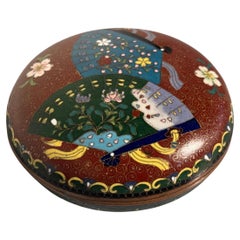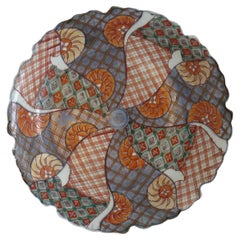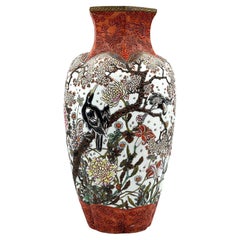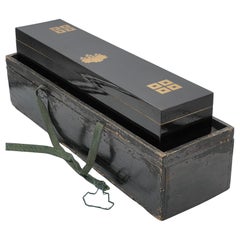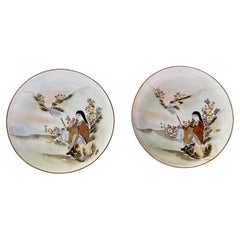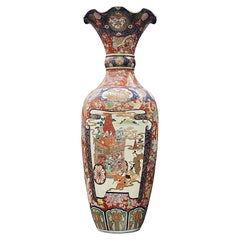Japanese Decorative Objects
Early 1900s Meiji Antique Japanese Decorative Objects
Copper, Enamel
19th Century Meiji Antique Japanese Decorative Objects
Porcelain
1890s Japonisme Antique Japanese Decorative Objects
Porcelain
1880s Japonisme Antique Japanese Decorative Objects
Wood
1850s Antique Japanese Decorative Objects
Porcelain
Late 19th Century Antique Japanese Decorative Objects
Porcelain
Late 19th Century Antique Japanese Decorative Objects
Lacquer
19th Century Meiji Antique Japanese Decorative Objects
Porcelain
1960s Chinoiserie Vintage Japanese Decorative Objects
Enamel
Early 20th Century Japanese Decorative Objects
Bamboo
19th Century Antique Japanese Decorative Objects
Bronze
Early 20th Century Edo Japanese Decorative Objects
Wood
Late 19th Century Antique Japanese Decorative Objects
Porcelain
20th Century Showa Japanese Decorative Objects
Porcelain
Late 19th Century Meiji Antique Japanese Decorative Objects
Lacquer
Early 20th Century Japonisme Japanese Decorative Objects
Copper
Mid-20th Century Showa Japanese Decorative Objects
Stoneware
19th Century Meiji Antique Japanese Decorative Objects
Stoneware
20th Century Minimalist Japanese Decorative Objects
Wood
21st Century and Contemporary Meiji Japanese Decorative Objects
Gold, Platinum, Silver, Foil
19th Century Meiji Antique Japanese Decorative Objects
Porcelain
Early 20th Century Meiji Japanese Decorative Objects
Porcelain
2010s Bauhaus Japanese Decorative Objects
Steel
17th Century Edo Antique Japanese Decorative Objects
Porcelain
Early 19th Century Edo Antique Japanese Decorative Objects
Pottery
19th Century Japonisme Antique Japanese Decorative Objects
Wood, Lacquer
19th Century Edo Antique Japanese Decorative Objects
Pottery
Mid-20th Century Mid-Century Modern Japanese Decorative Objects
Iron
1980s Post-Modern Vintage Japanese Decorative Objects
Art Glass
19th Century Meiji Antique Japanese Decorative Objects
Bronze
Mid-19th Century Antique Japanese Decorative Objects
Porcelain
1990s Modern Japanese Decorative Objects
Silver
Mid-18th Century Antique Japanese Decorative Objects
Porcelain
1920s Vintage Japanese Decorative Objects
Wood, Lacquer
20th Century Japanese Decorative Objects
Porcelain
Mid-20th Century Japonisme Japanese Decorative Objects
Porcelain
19th Century Japonisme Antique Japanese Decorative Objects
Bronze, Ormolu
15th Century and Earlier Other Antique Japanese Decorative Objects
Pottery
Late 19th Century Meiji Antique Japanese Decorative Objects
Bronze, Silver, Copper
Early 19th Century Edo Antique Japanese Decorative Objects
Bronze
Late 19th Century Antique Japanese Decorative Objects
Porcelain
20th Century Japonisme Japanese Decorative Objects
Bamboo
1950s Vintage Japanese Decorative Objects
Glass
19th Century Edo Antique Japanese Decorative Objects
Tin
Early 20th Century Meiji Japanese Decorative Objects
Gold
19th Century Edo Antique Japanese Decorative Objects
Pottery
Early 1900s Art Nouveau Antique Japanese Decorative Objects
Bronze
1970s Space Age Vintage Japanese Decorative Objects
Metal
18th Century Edo Antique Japanese Decorative Objects
Wood
Mid-20th Century Anglo-Japanese Japanese Decorative Objects
Bone, Bamboo, Wood
Mid-20th Century Showa Japanese Decorative Objects
Bronze
Late 20th Century Organic Modern Japanese Decorative Objects
Ceramic
19th Century Antique Japanese Decorative Objects
Porcelain
1980s Modern Vintage Japanese Decorative Objects
Ceramic
21st Century and Contemporary Meiji Japanese Decorative Objects
Porcelain
Late 18th Century Edo Antique Japanese Decorative Objects
Stone
Early 1900s Meiji Antique Japanese Decorative Objects
Bronze
Mid-20th Century Japanese Decorative Objects
Porcelain
1880s Antique Japanese Decorative Objects
Porcelain
21st Century and Contemporary Other Japanese Decorative Objects
Porcelain
Read More
Kazuyo Sejima’s Flowering Tree Blooms Year-Round
The brilliantly simple design turns a modest bouquet into a major statement.
He Wrote ‘Oedipus Rex,’ but Do You Know What He Looked Like?
The Greek tragedian is said to have been handsome in his day.
Cigar Culture Was Once the Peak of Masculinity. Now, It’s a Compelling Curiosity
Even for those who don’t indulge, elegant smoking accessories and audacious art portraying cigar enthusiasts hold a nostalgic allure.
African Travel Plans on Hold? This Ardmore Leopard Vase Brings the Beauty of the Savanna to You
It’s an excellent example of the sought-after ceramics coming out of South Africa’s KwaZulu-Natal province.
With a High-Tech Flagship and Cool Collabs, Lladró Is Breaking the Mold for Porcelain Production
Thanks to its new leadership, the Spanish maker of figurines, busts and lighting is on a mission to update the art of porcelain for the 21st century.
Zoë Powell’s Magnolia 05 Vessel Is Handmade from Clay She Unearthed Herself
The free-form stoneware piece is inspired by the magnolia tree and its associations with home.
8 Ways to Breathe New Life into a Space with Plants
The pair behind the Instagram account @houseplantclub share their tips for making any room of the house gloriously green.
Paris Gallerist Sandy Toupenet Gets Fired Up over 20th-Century Ceramics and Inventive New Makers
Her space on the city’s Left Bank mixes mid-century pieces by the likes of Jean Cocteau and Pablo Picasso with whimsical contemporary creations.
